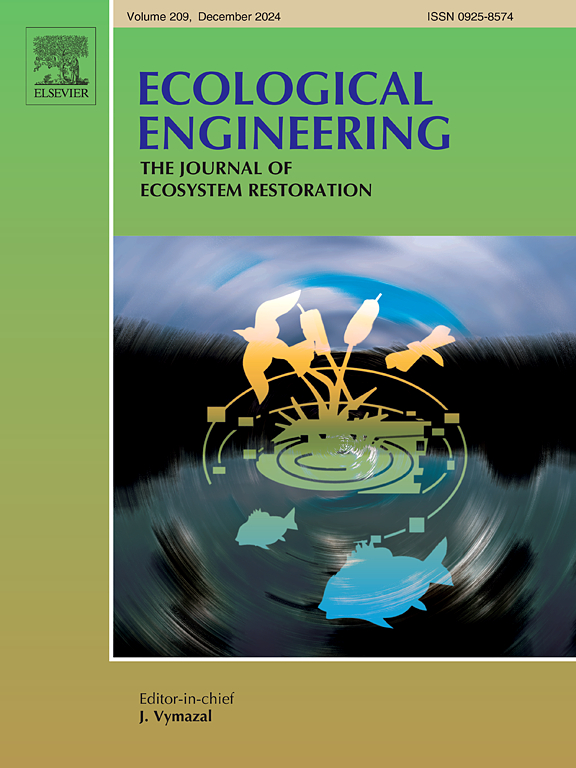Sediment transport evolution and impact on vegetation recovery in the Hanping village landslide–debris flow disaster chain in Shaanxi, China
IF 4.1
2区 环境科学与生态学
Q1 ECOLOGY
引用次数: 0
Abstract
The landslide–debris flow disaster chain, as a severe mode of slope material transport, significantly impacts regional geomorphological evolution and ecosystems. To better understand the long-term effects of sediment dynamics in the landslide–debris flow disaster chain, this study took the Hanping village landslide–debris flow disaster chain as a case study. By combining field investigations with dynamic simulations, the formation and evolutionary process of the disaster chain was reconstructed. A multisource remote sensing observation scheme integrating unmanned aerial vehicle and satellite remote sensing data was subsequently developed, which further revealed the characteristics of sediment transport and vegetation recovery over a prolonged postdisaster period. Our findings indicate that the formation and evolution of the disaster chain can be divided into four stages: landslide instability, landslide–debris flow transition, debris flow transport, and debris flow deposition. The transformation mechanism of the disaster chain is driven by the blockage failure effect at the bedrock narrows, followed by collision-induced disintegration that reduces particle size and increases water content. The deposits formed during different stages of the dynamic process exhibit significant compositional differences. Multisource remote sensing observations revealed significant spatiotemporal variations, with postdisaster deformation concentrated in channels and depositional regions. The time series deformation results further indicated that surface runoff induced by heavy rainfall exacerbated sediment transport, leading to notable deformation anomalies, with different material compositions exhibiting distinct transport patterns. Postdisaster monitoring revealed a significant increase in vegetation recovery, with an 80 % increase in vegetation area in the two years after the disaster (April 2022–March 2024). The proportion of areas with good recovery increased from 18.52 % to 41.34 % between 2022 and 2023. Moreover, a generalized feedback mechanism model describing sediment transport and vegetation recovery in landslide–debris flow disaster chains was proposed. This study, from a disaster evolutionary perspective, innovatively integrates numerical simulation with multisource remote sensing techniques to reveals the relationship between sediment transport and vegetation recovery, providing a foundation for ecological recovery efforts.
陕西汉坪村滑坡-泥石流灾害链泥沙运移演化及其对植被恢复的影响
滑坡-泥石流灾害链作为一种严重的坡面物质搬运方式,对区域地貌演化和生态系统具有重要影响。为了更好地了解滑坡-泥石流灾害链中泥沙动力学的长期效应,本研究以汉坪村滑坡-泥石流灾害链为例进行了研究。通过实地调查与动态模拟相结合,重构了灾害链的形成与演化过程。基于无人机和卫星遥感数据的多源遥感观测方案,进一步揭示了灾后较长时间内泥沙运移和植被恢复的特征。研究结果表明,该灾害链的形成与演化可分为4个阶段:滑坡失稳阶段、滑坡-泥石流过渡阶段、泥石流搬运阶段和泥石流沉积阶段。灾害链的转化机制是基岩处的堵塞破坏效应变窄驱动,随后发生碰撞崩解,颗粒减小,含水量增加。不同动态过程阶段形成的矿床具有明显的成分差异。多源遥感观测结果显示了明显的时空变化,灾后变形集中在河道和沉积区域。时间序列变形结果进一步表明,强降雨引起的地表径流加剧了沉积物的输运,导致了明显的变形异常,不同物质组成表现出不同的输运模式。灾后监测显示植被恢复明显增加,灾后2年(2022年4月- 2024年3月)植被面积增加80%。从2022年到2023年,采收率良好的地区占比从18.52%上升到41.34%。在此基础上,提出了滑坡-泥石流灾害链中泥沙输移与植被恢复的广义反馈机制模型。本研究创新性地从灾害演化的角度,将数值模拟与多源遥感技术相结合,揭示了泥沙运移与植被恢复的关系,为生态恢复提供了依据。
本文章由计算机程序翻译,如有差异,请以英文原文为准。
求助全文
约1分钟内获得全文
求助全文
来源期刊

Ecological Engineering
环境科学-工程:环境
CiteScore
8.00
自引率
5.30%
发文量
293
审稿时长
57 days
期刊介绍:
Ecological engineering has been defined as the design of ecosystems for the mutual benefit of humans and nature. The journal is meant for ecologists who, because of their research interests or occupation, are involved in designing, monitoring, or restoring ecosystems, and can serve as a bridge between ecologists and engineers.
Specific topics covered in the journal include: habitat reconstruction; ecotechnology; synthetic ecology; bioengineering; restoration ecology; ecology conservation; ecosystem rehabilitation; stream and river restoration; reclamation ecology; non-renewable resource conservation. Descriptions of specific applications of ecological engineering are acceptable only when situated within context of adding novelty to current research and emphasizing ecosystem restoration. We do not accept purely descriptive reports on ecosystem structures (such as vegetation surveys), purely physical assessment of materials that can be used for ecological restoration, small-model studies carried out in the laboratory or greenhouse with artificial (waste)water or crop studies, or case studies on conventional wastewater treatment and eutrophication that do not offer an ecosystem restoration approach within the paper.
 求助内容:
求助内容: 应助结果提醒方式:
应助结果提醒方式:


